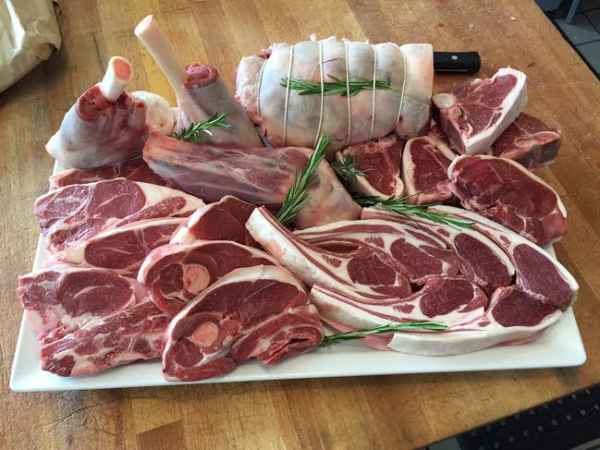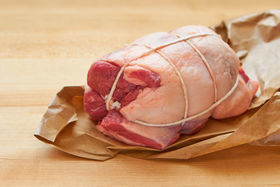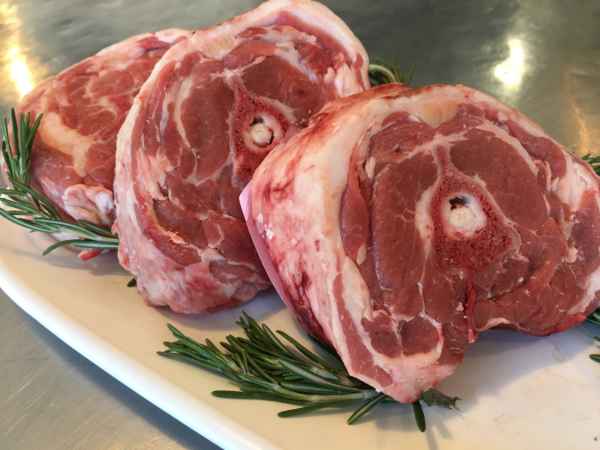
The shoulder of most animals are typically best braised until the meat falls off the bone. Lamb shoulder is a bit more versatile and is just as suitable as a roast; You can tie it up bone in, or to make carving easier have the blade-bone removed. If the shank is attached to the shoulder, make a cut around the bone end to release the tendons, so that the meat shrinks back from the bone as it cooks. And of course we always recommend keeping any removed bones for stock or to add flavor to soups and stews.
Lamb Shoulder Pot Roast Salad
Adapted from The Butcher’s Guide to Well Raised Meat, by Joshua and Jessica Applestone of Fleisher’s and Alexandra Zissu

- 5 lbs Boneless lamb shoulder, cleaned and tied.
- 4 shallots, unpeeled, halved
- 6 garlic cloves
- Coarse Sea Salt
- 2 cups chicken stock, or 1 cup lamb stock + 1 cup chicken stock
- 2 heads arugula or watercress
- small handful of chopped mint
- 1 cup cherries, pitted and diced
- 1 blood orange, halved and seeded
- 2 tablespoons pomegranate molasses (optional)
- 2 tablespoons pine nuts, toasted (optional)
- 3 tablespoons feta cheese (optional)
- Pita bread, warmed, for serving
Preheat the oven to 325°F. Heat a large ovenproof pot over medium heat. Add the lamb and brown it on all sides, 6 to 8 minutes total. Transfer the lamb to a platter. Add the shallots and garlic to the pot and cook, stirring, until they are soft and golden brown, about 4 minutes. Add a pinch of salt to the pot, then pour in the stock and bring the mixture to a boil. Return the lamb to the pot, cover, and transfer to the oven.
Roast the lamb for about 5 hours, until the lamb is literally falling apart. Take the lamb out of the oven and let it cool in the pot. About an hour before you want to eat, take the lamb out of the pot. Cut and remove the twine. Remove as much of the fat as possible and shred the meat into uniform pieces with two forks.
Put the arugula on a platter and put the shredded lamb on top. Sprinkle with coarse or flaky sea salt, the chopped mint and diced cherries. Talk one half of the blood orange and squeeze the juice over the salad (add the pomegranate molasses if you want a stronger, juicier, fruitier salad). Scatter the toasted nuts and feta, is using. Serve the salad while the lamb is still warm, before the lamb fat congeals, with the warmed pita on the side.
Lamb Neck is an economical cut, but that doesn’t mean it doesn’t taste good. Similar to oxtail, the connective and fatty tissues marbling the meat make the neck a rich cut perfect for braising. The flavor will cut through heavily spiced soups and stews, or you can shred the meat and toss with Gemelli noodles, braised leafy greens (chard, kale, dandelion), a shaoxing-wine sauce and garnished with shaved parmesan. However you like it, lamb neck is best prepared ahead of time so you have a chance to skim the fat off before serving.
Whole Lamb Neck with Lemons, Olives, and Mint
..from Odd Bits, by Jennifer McLagan

- A whole lamb neck (about 3# or more)
- Coarse sea salt and freshly ground black pepper
- 2 tablespoons rendered lamb fat or lard
- 2 onions, chopped
- 2 carrots, peeled and chopped
- 2 stalks celery, sliced
- 2 lemons
- 1 bunch fresh mint
- 1 head garlic
- 1 fresh bay leaf
- 1 dried chile (de arbol, Guajillo, or whatever you desire)
- 1 cup (250ml) dry white wine
- 2 cups (500ml) Lamb Stock
- 1 cup (5 ounces/140 grams) green olives
Remove the neck from your fridge an hour before cooking.
Preheat the oven to 325°F / 160°C
Pat the lamb dry and season well with salt and pepper. In a large, heavy flameproof casserole or Dutch oven, melt half of the fat over medium-high heat and brown the neck, then transfer to a plate.
Add the remaining fat with the onions, carrots, and celery to the pan, stir, and cook until the vegetables are slightly softened and beginning to stick to the pan.
Meanwhile, finely grate the zest from the lemons and set aside, and cut the lemons into thick slices, discarding the ends. Remove enough small leaves from the bunch of mint to make 1/2 cup (5g), then select 20 of the mint stems, setting the stems and leaves aside separately. Slice the top off the garlic head to expose the cloves. Add the lemons slices, mint stems, garlic, bay leaf, and chile to the pan. Pour in the wine and deglaze the pan, using a wooden spoon to scrape up the browned bits from the bottom.
Add the stock and bring to a boil. Return the neck to the pan, cover the lamb with a piece of wet parchment paper and the lid, transfer to the oven, and cook for 1 1/2 hours. Uncover the pan and remove the parchment paper and continue to cook until the meat is almost falling off the bone, about 1 hour.
Meanwhile, crack the olives using the flat side of a heavy chef’s knife (bottom of a pan will work, too). Remove and discard the pits, and set the olives aside.
Transfer the lamb neck to a carving board and loosely cover with aluminum foil to keep warm. Strain the cooking liquid through a sieve into a measuring cup, pressing on the vegetables to extract all the juice. Discard the veggies. Let the liquid stand for 5 minutes to allow the fat and broth to separate. Skim off the fat and discard (or save for another use!) Return the liquid to the pan, bring to a boil over medium heat, and boil until reduced by 25% (if starting with 2 cups, reduce to 1 1/2 cups).
Using a fork, pull the lamb off the bone in large pieces. Cut the lamb meat into thick slices and place in a warm serving dish. Add the olives to the sauce, check the seasoning, and pour the sauce over the sliced lamb. Add the mint leaves and lemon zest. Serve!

Thanks for the recipes